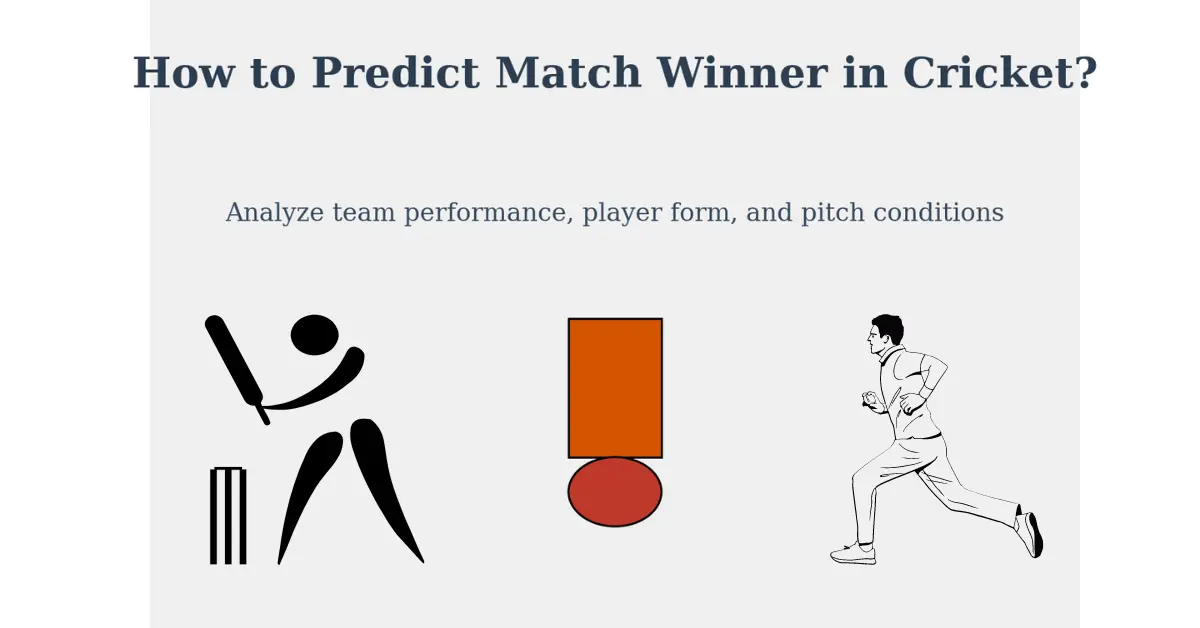Today, we will discuss How to Predict a Match Winner in Cricket. Predicting the winner of a cricket match can be both thrilling and challenging. With its complex rules and myriad influencing factors, Cricket offers a rich ground for analysis. Whether you’re a seasoned cricket enthusiast or just starting, understanding how to make educated predictions can heighten your enjoyment of the game. In this guide, we’ll explore the various elements that can help you anticipate the outcome of a cricket match with greater accuracy.
Understanding Cricket Basics
What Makes Cricket Unique?
Cricket isn’t just a sport; it’s a blend of strategy, endurance, and skill. Unlike many other sports, cricket matches can last anywhere from a few hours (in the T20 format) to five days (in Test matches). This variance in match duration adds a layer of complexity to predictions. Here’s why Cricket stands out:
- Multiple Formats: Test, One Day International (ODI), and Twenty20 (T20) each require different skill sets and strategies.
- Varied Playing Conditions: Playing conditions can vary significantly From the hard pitches in Australia to the turning tracks in India.
- Weather Dependency: Weather conditions can have a profound impact, often altering the course of a match.
The Basic Rules of Cricket
Before diving into prediction strategies, it’s crucial to grasp the basic rules of Cricket. Here’s a quick rundown:
- Teams and Innings: Two teams of eleven players each take turns batting and bowling. Each turn is called an inning.
- Scoring Runs: The batting team scores runs by hitting the ball, running between the wickets, or hitting boundaries.
- Types of Dismissals: Bowlers aim to dismiss batters in various ways, including being bowled, caught, run out, or leg before wicket (LBW).
- Match Formats: Each format has different rules regarding the number of overs and innings.
Understanding these basics is essential for analyzing how different elements might influence the match outcome.

Factors Influencing Match Outcomes
Team Form and Performance
One of the primary indicators of a team’s potential success is its current form and performance. When a team wins, they usually have a mental edge over the other team. Take a look at these things:
- Recent Matches: Look at the results of the last five to ten matches. Consistent wins indicate a substantial form.
- Winning Streaks: An ongoing winning streak usually has high confidence and momentum.
- Consistency Across Formats: Some teams excel in one format but struggle in another. Assess their performance in the specific format of the upcoming match.
Player Form and Fitness
Individual players can have a significant effect on how a match turns out. A star player in top form can single-handedly turn the tide. Here are vital aspects to consider:
- Key Players: Focus on the performance of key players, including batters, bowlers, and all-rounders.
- Recent Scores and Wickets: Analyze their recent scores or wickets taken to gauge current form.
- Fitness Levels: Injury reports and player fitness are crucial. An injured player, even if they play, may not perform at their best.
Weather Conditions
Weather is critical in Cricket, often affecting pitch conditions and gameplay. Here’s how it impacts the match:
- Rain: Can disrupt play, leading to reduced overs and altered strategies.
- Humidity and Cloud Cover: Can assist swing bowlers, making it difficult for batters.
- Heat: Can tire players quickly, affecting their performance, especially in longer formats.
Understanding these factors can enhance your ability to predict match outcomes more accurately. Always check the most recent weather forecasts and change your plans as needed.
Analyzing Team Strengths and Weaknesses
Batting Line-up Analysis
A strong batting line-up is crucial for a team’s success. When analyzing a team’s batting strength, consider the following:
- Top Order Batsmen: These players set the tone for the innings. Look at their consistency and ability to handle pressure.
- Middle Order Stability: The middle order often consolidates the innings. Check for players who can build partnerships and adapt to different match situations.
- Finishers: Players who can accelerate the scoring in the final overs are invaluable. Their ability to handle high-pressure situations can be decisive.
A balanced batting line-up with a mix of aggressive and defensive players is usually stronger when facing different bowling approaches.
Bowling Attack Assessment
A versatile, in-form bowling attack can dismantle even the most potent batting line-ups. Here’s how to assess a team’s bowling strength:
- Fast Bowlers: Evaluate their speed, accuracy, and ability to swing the ball. Fast bowlers are often more effective in conditions that favor pace and bounce.
- Spin Bowlers: Look at their variation and control. Spinners can be particularly effective on dry, turning pitches.
- All-rounders: Having players who can bat and bowl strengthens the team. Their versatility is crucial in adapting to changing match situations.
Consider the variety in the bowling attack. Teams with a mix of fast bowlers, spinners, and all-rounders are better equipped to exploit different pitch conditions.
Fielding Capabilities
Fielding is an integral part of Cricket that can make or break a game. Exceptional fielding can save runs and create opportunities for wickets. Key points to consider:
- Catching Ability: Safe hands in the field can capitalize on batters’ mistakes.
- Ground Fielding: Agile fielders can save crucial runs and build pressure on the batting side.
- Fielding Strategies: Teams that employ innovative fielding strategies, like setting aggressive fields or using specific players in critical positions, often have a competitive edge.
A team known for its sharp fielding skills can significantly enhance its chances of winning.
Importance of Pitch Conditions
Types of Pitches
Pitches play a pivotal role in Cricket. The pitch can have a significant effect on how the game turns out. Here are the main types:
- Green Pitches: These usually favor fast bowlers as the extra grass provides bounce and movement. Batsmen might find it challenging to score freely.
- Dry and Dusty Pitches: Such pitches often assist spin bowlers. As the match progresses, these pitches break up, making the spin more effective.
- Flat Pitches: Generally considered batting-friendly, flat pitches offer minor assistance to bowlers. High-scoring matches are standard on such surfaces.
Understanding the pitch type helps predict which team might have the upper hand.
How Pitches Affect Gameplay
Different pitches require different strategies. Here’s how various pitch conditions can influence gameplay:
- Bowling Tactics: Fast bowlers thrive on green pitches, while spinners dominate on dry, dusty surfaces. Teams might select bowlers best suited to the pitch conditions.
- Field Placements: Captains adjust field placements based on pitch behavior. Aggressive fields on bowling-friendly pitches can lead to more wickets, while defensive fields on flat pitches aim to contain runs.
- Batting Strategies: On flat pitches, teams might adopt an aggressive batting approach. On green or turning tracks, a more cautious approach may be necessary.
You can better plan and guess how teams will do by looking at playing conditions.

Impact of Home Advantage
Home vs. Away Performance
Playing at home provides several benefits to teams. Here’s why home advantage is significant:
- Familiar Conditions: Home teams are accustomed to the local pitches and weather conditions, giving them a strategic edge.
- Comfort and Routine: Players are in a familiar environment, which can positively impact their performance and mental state.
- Travel Fatigue: Visiting teams often face the added challenge of travel fatigue and adjusting to new conditions.
Examining a team’s home and away records can provide insights into their likely performance in upcoming matches.
Crowd Support
The home crowd can be a crucial factor in a team’s performance. Here’s how crowd support influences the game:
- Boosting Morale: A supportive crowd can lift the home team’s spirits, especially in tense moments.
- Intimidating Opponents: The noise and energy of a home crowd can intimidate visiting players, making it harder for them to concentrate.
- Momentum Shifts: The crowd’s reaction to critical moments can create momentum shifts that favor the home team.
Teams with solid home support often perform better, making crowd influence an essential factor in match predictions.
Role of Toss in Match Outcomes
Deciding to Bat or Bowl First
Winning the toss gives a team a strategic advantage. Several factors influence the decision to bat or bowl first:
- Pitch Conditions: Teams may bat first on a flat pitch to post a high score or bowl first on a green pitch to exploit early movement.
- Weather Forecast: Overcast conditions can favor bowlers, prompting a team to bowl first. Conversely, sunny weather might encourage batting first.
- Team Strengths: Teams often decide based on their strengths. A strong batting line-up might prefer to set a target, while a potent bowling attack might opt to chase.
The toss decision can significantly impact the match’s outcome, and understanding its rationale is critical to making accurate predictions.
Historical Toss Data
Analyzing historical toss data can provide valuable insights:
- Venue Trends: Some venues have a clear trend where teams winning the toss prefer a particular option (batting or bowling first) and often succeed.
- Team Patterns: Certain teams take a consistent approach to the toss based on their playing style and past successes.
Analyzing past data can help you find trends that could affect the current match, helping you make a more informed prediction.
Statistical Analysis and Historical Data
Head-to-Head Records
One of the most reliable predictors of match outcomes is the historical head-to-head record between the two teams. This data can reveal patterns and psychological edges. Here’s what to look for:
- Overall Record: Who has won more matches in their past encounters?
- Recent Matches: Focus on the last few games as they are more reflective of the current form.
- Home vs. Away: How do the teams perform against each other in different locations? Some teams excel at home but struggle away.
Understanding these dynamics can help you see which team might have the upper hand in the upcoming match.
Recent Performance Trends
Recent form strongly indicates a team’s current capabilities and mindset. Here’s how to analyze performance trends:
- Win-Loss Ratio: Look at the number of wins versus losses in recent matches. Teams with more wins are generally in better form.
- Consistency: Performance consistency is key. A team that wins regularly against various opponents is likely more reliable.
- Key Players’ Contributions: Are star players performing well? Teams with critical players in good form are more likely to win.
By examining recent performance trends, you can gauge which team is on an upward trajectory and more likely to succeed.
Psychological Factors and Team Morale
Leadership and Captaincy
The role of a captain in Cricket cannot be overstated. A robust and strategic leader can significantly influence the outcome of a match. Here’s what to consider:
- Decision-Making: Effective captains make intelligent decisions regarding batting orders, bowling changes, and field placements.
- Inspirational Leadership: Captains who inspire and motivate their team can elevate overall performance.
- Past Records: Look at the captain’s records in similar situations. Experienced captains with a history of success are often more dependable.
A good captain not only leads by example but also knows how to leverage the strengths of their team.
Team Dynamics
Team morale and cohesion play a critical role in performance. A team that works well together often outperforms one with internal conflicts. Consider the following:
- Camaraderie: Teams with strong bonds and good communication typically handle pressure better.
- Conflict Management: How does the team handle disputes or controversies? Effective conflict management can prevent disruptions in performance.
- Support Systems: The presence of experienced coaches and support staff can enhance team dynamics and provide strategic advantages.
Observing the dynamics within the team can provide insights into their potential performance.
Injury Reports and Player Availability
Key Player Injuries
Injuries can drastically alter a team’s strategy and performance. Here’s what to keep in mind:
- Impact of Injuries: Assess how the absence of critical players affects the team. For example, losing a star batter or bowler can be a significant blow.
- Recovery and Fitness Levels: Players returning from injury might not be at their best. Evaluate their recent performances and fitness levels.
- Substitutes: Consider the depth of the squad. Teams with capable substitutes can better cope with injuries.
Observing injury reports can help you understand how team composition and strategies might change.
Impact on Team Strategy
Player availability directly impacts team strategy and formation. Here’s how:
- Line-up Changes: Injuries may force teams to alter their batting or bowling order.
- Tactical Adjustments: Teams might adopt different tactics to compensate for missing key players.
- Psychological Impact: The team’s Morale can be affected by the absence of influential players.
By looking at how injuries change team strategies, you can make more accurate guesses about how games will turn out.
Expert Opinions and Predictions
Insights from Cricket Analysts
Cricket analysts provide valuable insights based on their deep understanding of the game. Here’s why their opinions matter:
- Data-Driven Analysis: Analysts use extensive data and statistical models to make predictions.
- Experience: Their experience in the sport allows them to identify subtle factors that might influence the match.
- Objective Views: Analysts provide an objective view, free from fan biases, offering a clearer picture of the match.
Following reputable cricket analysts can enhance your understanding and help you make better predictions.
Media and Commentator Predictions
Media and commentators often have insider knowledge and access to team news that isn’t publicly available. Here’s how they contribute to predictions:
- Expert Commentary: Commentators often provide real-time insights during matches, highlighting key moments and strategies.
- Pre-Match Analysis: Media outlets offer detailed pre-match analyses, including team news, pitch reports, and weather forecasts.
- Trends and Rumors: Media sources can uncover trends and rumors that might not be evident from statistical data alone.
Incorporating media and commentator predictions into your analysis can provide a well-rounded view of the upcoming match.
Utilizing Technology and Data Analytics
Role of Big Data in Cricket
In the modern era, big data has revolutionized how Cricket is analyzed and understood. Here’s how big data plays a crucial role:
- Performance Metrics: Detailed statistics on players’ performances, including strike rates, averages, and wicket-taking patterns, provide deep insights.
- Match Simulations: Advanced algorithms can simulate matches based on historical data, providing probable outcomes and scenarios.
- Player Tracking: Tools like Hawk-Eye and ball-tracking systems analyze player movements and trajectories to understand performance intricacies.
Big data allows for a more nuanced understanding of the game, enabling more accurate predictions.
Predictive Analytics Tools
Predictive analytics tools use data and machine learning to guess how matches will go. This is what they do to help:
- Data Integration: Combining historical data, real-time stats, and external factors to generate comprehensive predictions.
- Trend Analysis: Identifying patterns and trends that are not immediately obvious, such as a player’s performance against a particular type of bowler.
- Scenario Planning: Evaluating different match scenarios to predict possible outcomes based on current data.
These tools can give you a big edge when you pick match wins.

Betting Odds and Market Sentiment
Understanding Betting Odds
Betting odds provide a quantifiable measure of a team’s chances of winning. Here’s how to interpret them:
- Decimal Odds: Show how much you win for each unit you bet. For example, odds of 2.5 mean you win $2.50 for every $1 bet.
- Fractional Odds: Show the profit ratio to the stake. For instance, 5/2 odds mean you win $5 for every $2 bet.
- Moneyline Odds: When betting in the United States, favorable (+) odds indicate how much you win on a $100 bet, while unfavorable (-) odds indicate how much you must wager to earn $100.
Understanding these odds can help you gauge market sentiment and make informed decisions.
How Market Trends Influence Perception
Market trends reflect public and expert opinions about a match. Here’s how they can influence perception:
- Shifting Odds: Rapid changes in odds can indicate significant news, such as a key player’s injury or unexpected weather conditions.
- Betting Volumes High betting volumes on a particular outcome suggest solid public confidence in that result.
- Sentiment Analysis: Social media and news mood analysis can give you more information about how the market sees a match.
By staying attuned to market trends, you can better understand how public perception might affect the game.
Common Pitfalls to Avoid
Overvaluing Recent Performance
While recent performance is an important indicator, it’s crucial not to overemphasize it. Here’s why:
- Small Sample Size: Recent matches represent a small sample size and may not reflect overall capabilities.
- Variance: Performance can fluctuate due to opposition quality, match conditions, and individual form.
- Long-Term Trends: To get a better picture, it’s crucial to balance recent performance with long-term trends.
Ignoring External Factors
External factors can significantly influence a match. Here’s what to avoid ignoring:
- Weather Conditions: Rain, humidity, and temperature can affect pitch conditions and player performance.
- Travel Fatigue: Teams traveling long distances may suffer from fatigue, affecting their performance.
- Off-Field Issues: Internal team conflicts, player controversies, or coaching changes can disrupt team harmony and performance.
Considering these external factors ensures a more holistic and accurate prediction.
Conclusion of How to Predict Match Winner in Cricket?
Analyzing Cricket Match Predictions is an art combining various elements, from understanding the basic rules to analyzing advanced data. You can make well-informed predictions by considering team strengths, pitch conditions, psychological factors, and the latest technology. Remember, no prediction method is foolproof, but by carefully looking into it and keeping up with the latest news, you can significantly increase your chances of making accurate predictions.
->Become A Pro With Cricket Betting Tips Guru (2024)
The toss can significantly influence match outcomes, especially in conditions that favor either batting or bowling first. Teams often base their strategies on the toss result.
Yes, weather conditions can change and impact the match. Rain can shorten the game, while cloud cover can aid swing bowlers. Always check the weather forecast.
Both are important. Recent form shows the team’s current state, while historical performance provides a broader perspective. Balancing both gives a better prediction.
Injuries to key players can disrupt team balance and strategy. It’s crucial to consider the impact of player availability when making predictions.
Expert opinions are valuable as they are based on deep knowledge and analysis. However, they should be one of many factors considered in your prediction process.






3 Replies to “How to Predict Match Winner in Cricket?”
[…] ->How To Predict Match Winner In Cricket? […]
[…] the theory is great, but practical tips can help you implement a winning strategy. Here are some actionable steps to choose the better […]
[…] ->How To Predict Match Winner In Cricket? […]